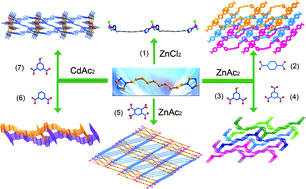Diverse topologies of seven d10 coordination polymers constructed from a long ligand and different carboxylates†
Abstract
A long flexible ligand, btd = 1,10-bis(1,2,4-triazol-1-yl)decane, has been prepared. Seven new Zn(II) and Cd(II) coordination polymers based on btd ligand and different carboxylate anions, namely, [Zn(btd)Cl2] (1), [Zn2(btd)(L1)1.5(HL1)]·H2O (2), [Zn(btd)(L2)]·H2O (3), [Zn2(btd)2(HL3)2]·4H2O (4), Zn2(btd)2(L4) (5), [Cd(btd)(L2)(H2O)]·H2O (6) and [Cd4(btd)3(L5)4]·H2O (7), where H2L1 = 1,4-benzenedicarboxylic acid, H2L2 = 5-hydroxy-1,3-benzenedicarboxylic acid, H3L3 = 1,3,5-benzenetricarboxylic acid, H4L4 = 1,2,4,5-benzenetetracarboxylic acid and H2L5 = 1,3-benzenedicarboxylic acid, have been synthesized under hydrothermal conditions. Their structures have been determined by single-crystal X-ray diffraction analyses and further characterized by infrared spectra (IR) and elemental analyses. In 1, the Zn(II) atoms are bridged by btd ligands to generate an infinite 1D chain, which is arranged in different propagating directions. Compound 2 exhibits an entanglement of a 2D → 3D entangled framework with both interpenetration and interdigitation characters, where each sheet is simultaneously interdigitated by two adjacent layers. In compounds 3 and 4, the undulated (44)-sql layers interpenetrate each other resulting in a 2D → 2D interpenetrating network with the carboxylate ligands as arms hanging up both sides of the layer, where the arms of the adjacent non-interpenetrated layers are interdigitated to give a 2D → 2D → 3D framework. Compound 5 shows a 4-connected 3D framework with a Schläfli symbol of 62·84. Compound 6 exhibits a fascinating example of 2D → 2D interdigitation with the sql nets using L1 ligands. In compound 7, the binuclear Cd(II) clusters are linked by L5 anions to construct a Cd-carboxylate chain, and adjacent chains are further extended by btd ligands to generate a 2D net, which are further extended into a 3D supramolecular motif through strong π–π stacking. Moreover, elemental analyses, IR spectra, and luminescent properties of these compounds were also studied.


 Please wait while we load your content...
Please wait while we load your content...